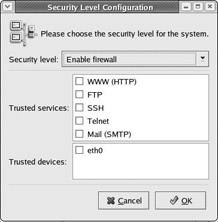Connecting Securely
Most people, particularly home users, connect their computers directly to the Internet. While this allows you to freely access information available on the Internet, it also brings with it some inherent perils . Malicious users and programs will often try to break into your computer, which can result in loss of data and often puts you in a position of liability for actions that are not yours. Therefore, it is necessary to at least take some rudimentary precautions to protect your system. Fortunately, viruses and worms that commonly affect Microsoft platforms in general do not affect Fedora Linux and UNIX systems. However, UNIX systems are still vulnerable to external attack.
The most common mode of attack on a UNIX and therefore a Fedora Linux system is via network services that are available for clients on the network to access. Examples of services include Web servers, FTP service, and the Telnet service. Fortunately, it is possible to secure these services by setting up the firewall feature that is available as part of Fedora Linux. You can access the firewall settings from the Start menu by going to System Settings>Security Level (see Figure 3-17).

Figure 3-17
You can enable or disable the firewall by selecting the appropriate security level from the drop-down list. You may also specify which services are trusted. When a service is trusted, clients from the Internet or your local network can access it. Additionally, you can specify which of the network devices (for example, network cards or modems) are trusted by you. Network clients cannot connect to any services on an untrusted device.
Be aware that the firewall takes a minimalist approach ”that is, it disallows all possible services. It is up to you as the user to specify which services should be accessible. There is always the danger that a service that you assumed to be always running may now be blocked by the firewall. A common technique while troubleshooting network services is to shut down the firewall temporarily during the troubleshooting process. System security is discussed in detail in later chapters.
EAN: 2147483647
Pages: 170
- Using SQL Data Definition Language (DDL) to Create Data Tables and Other Database Objects
- Working with Queries, Expressions, and Aggregate Functions
- Creating Indexes for Fast Data Retrieval
- Writing External Applications to Query and Manipulate Database Data
- Working with SQL Database Data Across the Internet